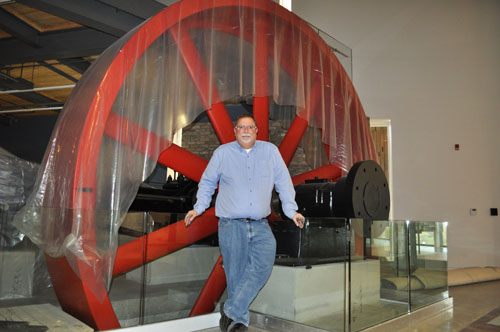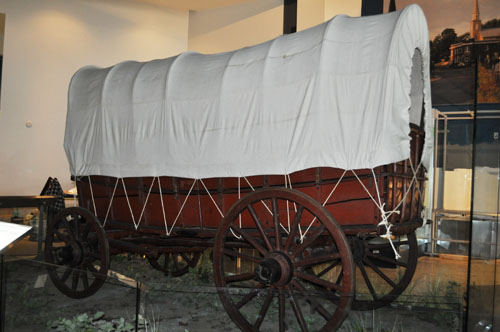


By Carrie Debrone
Kitchener Citizen
Who’s Hazel? What’s a velocipede? What was the name of the car made in Kitchener? Come to the Waterloo Region Museum and find out.
Residents of the Region of Waterloo will soon have the chance to better know themselves and the area where they live through the unique experience that only this great local museum can offer.
The Waterloo Region Museum will hold its grand opening and launch of three new exhibits on November 12 and 13. Located at the intersection of Homer Watson Blvd and Huron Rd in Kitchener, it is the largest municipally-owned and operated museum in Ontario.
Everyone is invited to the opening and admission is free for the weekend celebration.
The $26-million, 47,000-squarefoot facility, which has become a popular conference and wedding venue since the main part of the building was opened about a year and half ago, now features three exhibits: What Makes Us Who We Are? – an exploration of more than 12,000 years of Waterloo Region’s history; and Unconventional Thinking: Innovation in Waterloo Region and the Waterloo Region Hall of Fame.
As the finishing exhibit touches were being installed last week Tom Reitz, General Manager/Curator took the time to explain what visitors can expect.
During the interview and tour, his eyes dance and his words burn with a passion for his work, which he hopes will be educational, emotional and entertaining for museum visitors.
“There’s just nothing like this in Ontario. We’re looking for people to make a connection here – to have those ‘ah ha’ moments. I think we’re going to surprise people. There’s lots of 20th and 21st century information. There may even be some heart stopping, tearful moments,” Reitz said.
“Sourcing all these great local stories was very time consuming but it’s been exhilarating and very exciting for myself and our staff.”
Some of the objects in the three exhibits have been stored for almost 100 years-- waiting for a space like this in which to be properly displayed.
As early as 1912 the Waterloo Historical Society started collecting artefacts and the museum has almost 43,000 items in storage including the 1770’s Weber Conestoga wagon that brought Abraham Weber here from Pennsylvania in 1807.
“It’s one of the key artifacts being used in this exhibit to tell the local story of immigration,” says Reitz. The wagon is just one of many large items on display, which are used in the exhibit’s exploration of more than 12,000 years of
Waterloo Region’s history.
One of the first things you see at the exhibit area entrance is a huge, red fly wheel and steam engine nicknamed ‘Hazel.’ Built in Galt in 1908 by Goldie McCulloch (a steam works factory that was located where the Southworks Outlet Mall in Galt now stands) Hazel was used to power the Kaufman Footwear plant in Kitchener and kept the entire factory running. It was named after the newspaper comic strip Hazel (which later was made into an early TV sitcom of the same name) about a buxom maid named Hazel who kept the household running.
Part of this exhibit will allow visitors the chance to tell others about the pet names they may have for the machines they use everyday such as their car or lawnmower.
The entrance, flanked by a two-storey luggage rack, also boasts an educational exhibit on why people immigrated to Waterloo region telling the personal stories of five different people who settled here.
Aiding in making that personal connection, each story is accompanied by an item used by that person.
One story is about a Dutch war bride who moved to New Hamburg at the end of WorldWar II for love. Her luggage trunk and a poem written in Dutch expressing good wishes to her from her grandparents helps to tell her story.
A bamboo splint basket from the 1800s helps bring to life the story of Tom Lee who came to Galt in 1897 to run the Chinese laundry. He came to Canada for a better life.
Also on display in the immigration section is a suitcase that carried the toys of Erika Witzke from Poland as she and her family immigrated to this area to escape the ravages of war.
The fourth and fifth stories are of Vincent Toolsie who came to Waterloo in 1954 from Guyana to study at what is now Wilfrid Laurier University and the story of John and Eliza Little who came to Canada for freedom escaping from the United States in the 1800s on the Underground Railroad.
“I think this section will be very emotional for some people especially for recent immigrants who will remember their own circumstances and what brought them here. But for everyone who lives here, it will remind them to think about how their ancestors came to Canada,” Reitz said.
The section will also feature a video presentation of the stories of more than 40 of Waterloo region’s recent immigrants who were interviewed several months ago about why they came and what challenges they have faced.
Visitors will also be able to view film footage of Ausma Levalds arriving from Latvia as the 50,000th Displaced Person to enter Canada in the 1940s.
Surrounding the main floor exhibits are seven huge photographic panels, each representing one of the seven municipalities of this region. Sourced from Flickr, the photos were all taken by local photographers. Below the photo panels, are interpretive panels containing information about this area’s First Nations people, the German and Scottish pioneers, and the large Portuguese and Newfoundland communities that followed later.
The Community Highlight Exhibit – The Hmong in Waterloo Region highlights the Hmong people who immigrated here from Laos and Thailand. During the Vietnam War they sided with the Americans and ended up in refugee camps. This small and very distinct local Asian community has loaned the museum beautiful cultural objects, which will be on display for the year. Each year, The Community Highlight Exhibit will change to feature a different local community.
Anchored by several large historical objects, including a threshing machine that helps tell the story of food production and local agriculture, the museum’s main floor galleries are laid out without a fixed route, so visitors can enjoy the exhibits in whatever order they choose.
There is a Tiger Brand knitting machine. an antique table saw and many manufacturing and factory artifacts that highlight the history to present day of manufacturing in the region, with education displays on the differences in workplaces, local unions, and the role of women in factory work.
A display called Shift Change acknowledges the contributions of former businesses that have now left the community such as shoemakers, hat manufacturers, breweries and tanneries. Visitors will see a large bell tower, complete with the bell, salvaged from the Eagle Tannery in Kitchener. It helps tell the stories of two prominent local families, the Breithaupts and the Hespelers, and the very different, yet distinctive, impacts they had on the development of Waterloo region.
The drafting tools used to design the West Montrose Covered Bridge are on display.
The local car manufacturing industry is showcased by a 1989 Toyota Corolla, the 8th car off the line in Canada and sold to Claudette Millar, former Cambridge mayor. Here there is also a video showing the manufacturing of a modern car using robots. This is juxtaposed with a video of the manufacturing of a car in the 1920s, built by people. The videos are synchronized so that the viewer
sees both cars drive off the production line at the same time. Also on display is a 1914 tire made by Dominion Tire and the last tire off the line at the former BF Goodrich plant.
Anchored by the last Lazy Boy chair off the assembly line in Waterloo, there are also displays on the commercial products that have made our lives easier including Schneider’s foods, local liquor and beer producers, cookie and candy makers and local appliance manufacturers.
A flat bed truck, once driven across the province by Ontario Hydro to encourage people to welcome hydro into their homes and farms is also on display. On loan to the museum from the Canada Museum of Science and Technology, the truck helps tell the
story of Ontario Hydro and its three local founding fathers -- Snider, Beck and Detweiler. These three men believed that hydroelectric power, if transmitted under public ownership, would provide the least expensive power source for manufacturing. Under the slogan "Power for the People," they lobbied the provincial government to assume ownership of Ontario's waterpower potential and because of their efforts, in 1910 Berlin (later Kitchener) was given the privilege of having the first overhead streetlights powered by hydro produced by Niagara Falls.
You will see what looks like an upside-down bicycle called a ‘velocipede’ that was ridden across the Niagara Falls gorge by an 1860’s daredevil named Professor Andrew Jenkins from Branchton (near Ayr). The mannequin riding the bicycle has a face modeled from photographs of the late Jenkins.
“It’s one of those odd things in our collection that allowed us to make local connections,” said Reitz.
The second floor exhibit area houses the Waterloo Region Hall of Fame featuring local athletes, musicians and people who have made a significant impact in our community.
On display in the Unconventional Thinking: Innovation in Waterloo Region exhibit, visitors are invited to examine inventions, what they are, how to get a patent and what it takes to move an invention from an idea into mainstream acceptance.
Local unconventional thinking and its impact is also honoured with displays on the area’s high tech sectors. Here the local history of innovation is examined with a display of the Electrohome ‘Circa 75’, which was designed to do everything the Internet can do before there was Internet, to the most modern ATM developed by National Cash Register in Waterloo to the RIM BlackBerry.
A fun and interactive game in this exhibit area offers visitors the chance to play a Dragon’s Den like character and vote on old invention ideas.
“I feel incredibly privileged to be doing this work. It’s an amazing and beautiful building and I’m proud to be part of such an important project that the region has invested this amount of money and commitment into,” Reitz said.
Kitchener Citizen
Who’s Hazel? What’s a velocipede? What was the name of the car made in Kitchener? Come to the Waterloo Region Museum and find out.
Residents of the Region of Waterloo will soon have the chance to better know themselves and the area where they live through the unique experience that only this great local museum can offer.
The Waterloo Region Museum will hold its grand opening and launch of three new exhibits on November 12 and 13. Located at the intersection of Homer Watson Blvd and Huron Rd in Kitchener, it is the largest municipally-owned and operated museum in Ontario.
Everyone is invited to the opening and admission is free for the weekend celebration.
The $26-million, 47,000-squarefoot facility, which has become a popular conference and wedding venue since the main part of the building was opened about a year and half ago, now features three exhibits: What Makes Us Who We Are? – an exploration of more than 12,000 years of Waterloo Region’s history; and Unconventional Thinking: Innovation in Waterloo Region and the Waterloo Region Hall of Fame.
As the finishing exhibit touches were being installed last week Tom Reitz, General Manager/Curator took the time to explain what visitors can expect.
During the interview and tour, his eyes dance and his words burn with a passion for his work, which he hopes will be educational, emotional and entertaining for museum visitors.
“There’s just nothing like this in Ontario. We’re looking for people to make a connection here – to have those ‘ah ha’ moments. I think we’re going to surprise people. There’s lots of 20th and 21st century information. There may even be some heart stopping, tearful moments,” Reitz said.
“Sourcing all these great local stories was very time consuming but it’s been exhilarating and very exciting for myself and our staff.”
Some of the objects in the three exhibits have been stored for almost 100 years-- waiting for a space like this in which to be properly displayed.
As early as 1912 the Waterloo Historical Society started collecting artefacts and the museum has almost 43,000 items in storage including the 1770’s Weber Conestoga wagon that brought Abraham Weber here from Pennsylvania in 1807.
“It’s one of the key artifacts being used in this exhibit to tell the local story of immigration,” says Reitz. The wagon is just one of many large items on display, which are used in the exhibit’s exploration of more than 12,000 years of
Waterloo Region’s history.
One of the first things you see at the exhibit area entrance is a huge, red fly wheel and steam engine nicknamed ‘Hazel.’ Built in Galt in 1908 by Goldie McCulloch (a steam works factory that was located where the Southworks Outlet Mall in Galt now stands) Hazel was used to power the Kaufman Footwear plant in Kitchener and kept the entire factory running. It was named after the newspaper comic strip Hazel (which later was made into an early TV sitcom of the same name) about a buxom maid named Hazel who kept the household running.
Part of this exhibit will allow visitors the chance to tell others about the pet names they may have for the machines they use everyday such as their car or lawnmower.
The entrance, flanked by a two-storey luggage rack, also boasts an educational exhibit on why people immigrated to Waterloo region telling the personal stories of five different people who settled here.
Aiding in making that personal connection, each story is accompanied by an item used by that person.
One story is about a Dutch war bride who moved to New Hamburg at the end of WorldWar II for love. Her luggage trunk and a poem written in Dutch expressing good wishes to her from her grandparents helps to tell her story.
A bamboo splint basket from the 1800s helps bring to life the story of Tom Lee who came to Galt in 1897 to run the Chinese laundry. He came to Canada for a better life.
Also on display in the immigration section is a suitcase that carried the toys of Erika Witzke from Poland as she and her family immigrated to this area to escape the ravages of war.
The fourth and fifth stories are of Vincent Toolsie who came to Waterloo in 1954 from Guyana to study at what is now Wilfrid Laurier University and the story of John and Eliza Little who came to Canada for freedom escaping from the United States in the 1800s on the Underground Railroad.
“I think this section will be very emotional for some people especially for recent immigrants who will remember their own circumstances and what brought them here. But for everyone who lives here, it will remind them to think about how their ancestors came to Canada,” Reitz said.
The section will also feature a video presentation of the stories of more than 40 of Waterloo region’s recent immigrants who were interviewed several months ago about why they came and what challenges they have faced.
Visitors will also be able to view film footage of Ausma Levalds arriving from Latvia as the 50,000th Displaced Person to enter Canada in the 1940s.
Surrounding the main floor exhibits are seven huge photographic panels, each representing one of the seven municipalities of this region. Sourced from Flickr, the photos were all taken by local photographers. Below the photo panels, are interpretive panels containing information about this area’s First Nations people, the German and Scottish pioneers, and the large Portuguese and Newfoundland communities that followed later.
The Community Highlight Exhibit – The Hmong in Waterloo Region highlights the Hmong people who immigrated here from Laos and Thailand. During the Vietnam War they sided with the Americans and ended up in refugee camps. This small and very distinct local Asian community has loaned the museum beautiful cultural objects, which will be on display for the year. Each year, The Community Highlight Exhibit will change to feature a different local community.
Anchored by several large historical objects, including a threshing machine that helps tell the story of food production and local agriculture, the museum’s main floor galleries are laid out without a fixed route, so visitors can enjoy the exhibits in whatever order they choose.
There is a Tiger Brand knitting machine. an antique table saw and many manufacturing and factory artifacts that highlight the history to present day of manufacturing in the region, with education displays on the differences in workplaces, local unions, and the role of women in factory work.
A display called Shift Change acknowledges the contributions of former businesses that have now left the community such as shoemakers, hat manufacturers, breweries and tanneries. Visitors will see a large bell tower, complete with the bell, salvaged from the Eagle Tannery in Kitchener. It helps tell the stories of two prominent local families, the Breithaupts and the Hespelers, and the very different, yet distinctive, impacts they had on the development of Waterloo region.
The drafting tools used to design the West Montrose Covered Bridge are on display.
The local car manufacturing industry is showcased by a 1989 Toyota Corolla, the 8th car off the line in Canada and sold to Claudette Millar, former Cambridge mayor. Here there is also a video showing the manufacturing of a modern car using robots. This is juxtaposed with a video of the manufacturing of a car in the 1920s, built by people. The videos are synchronized so that the viewer
sees both cars drive off the production line at the same time. Also on display is a 1914 tire made by Dominion Tire and the last tire off the line at the former BF Goodrich plant.
Anchored by the last Lazy Boy chair off the assembly line in Waterloo, there are also displays on the commercial products that have made our lives easier including Schneider’s foods, local liquor and beer producers, cookie and candy makers and local appliance manufacturers.
A flat bed truck, once driven across the province by Ontario Hydro to encourage people to welcome hydro into their homes and farms is also on display. On loan to the museum from the Canada Museum of Science and Technology, the truck helps tell the
story of Ontario Hydro and its three local founding fathers -- Snider, Beck and Detweiler. These three men believed that hydroelectric power, if transmitted under public ownership, would provide the least expensive power source for manufacturing. Under the slogan "Power for the People," they lobbied the provincial government to assume ownership of Ontario's waterpower potential and because of their efforts, in 1910 Berlin (later Kitchener) was given the privilege of having the first overhead streetlights powered by hydro produced by Niagara Falls.
You will see what looks like an upside-down bicycle called a ‘velocipede’ that was ridden across the Niagara Falls gorge by an 1860’s daredevil named Professor Andrew Jenkins from Branchton (near Ayr). The mannequin riding the bicycle has a face modeled from photographs of the late Jenkins.
“It’s one of those odd things in our collection that allowed us to make local connections,” said Reitz.
The second floor exhibit area houses the Waterloo Region Hall of Fame featuring local athletes, musicians and people who have made a significant impact in our community.
On display in the Unconventional Thinking: Innovation in Waterloo Region exhibit, visitors are invited to examine inventions, what they are, how to get a patent and what it takes to move an invention from an idea into mainstream acceptance.
Local unconventional thinking and its impact is also honoured with displays on the area’s high tech sectors. Here the local history of innovation is examined with a display of the Electrohome ‘Circa 75’, which was designed to do everything the Internet can do before there was Internet, to the most modern ATM developed by National Cash Register in Waterloo to the RIM BlackBerry.
A fun and interactive game in this exhibit area offers visitors the chance to play a Dragon’s Den like character and vote on old invention ideas.
“I feel incredibly privileged to be doing this work. It’s an amazing and beautiful building and I’m proud to be part of such an important project that the region has invested this amount of money and commitment into,” Reitz said.


Tom Reitz stands in front of "Hazel" a fly wheel and steam engine that used to power the Kaufman Footwear plant in Kitchener. It is one of several large historical artifacts on display at theWaterloo Regional Museum. The museum will celebrate its grand opening Nov. 12 and 13. Admission for the weekend is free.
This 1770's Conestoga wagon, the historical version of a moving van, brought Abraham Weber to the Region of Waterloo from Pennsylvania in 1807.
Waterloo Region Museum grand opening and exhibit launch